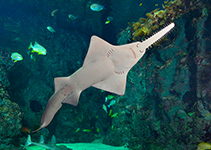| Family: |
Pristidae (Sawfishes) |
| Max. size: |
750 cm TL (male/unsexed); max. reported age: 30 years |
| Environment: |
demersal; freshwater; brackish; marine; depth range - 25 m, oceanodromous |
| Distribution: |
Circumglobally in tropical and subtropical waters, entering estuaries and littoral lagoons and ascending river courses (Ref. 81284, 81624). Western Atlantic: Florida and Louisiana, USA to Brazil (Ref. 7251); eastern Atlantic: Portugal to Angola, including the western Mediterranean Sea (Ref. 4429; no report since the 19th century [Ref. 116564] ); western Pacific: northern Australia, from western Australia to Queensland (Ref. 7300); eastern Pacific: Gulf of California to Ecuador (Ref. 4429). In freshwater it can be found in rivers of West Africa (Ref. 81284), Ogowe River (Ref. 81284) and the Congo River estuary (Ref. 377, 81284). |
| Diagnosis: |
Diagnosis: Rostral blade with 20 or fewer pairs of rostral spines (Ref. 81624).
Description: Pristis pristis is characterized by its long and thin rostral teeth, grooved on their hind margin and numbering less than 20 pairs (Ref. 81284, 81624). First dorsal fin originating slightly anterior to pelvic fin origin and base longer than second dorsal fin (Ref. 81284, 81624). Second dorsal fin positioned well posterior to pelvic fins (Ref. 81624). Caudal fin shark-like, with a large dorsal lobe and a reduced, but distinct, small ventral lobe (Ref. 81284, 81624).
Colouration: Back brownish-grey to ochre, belly white, greyish-white or yellowish-white and without any distinctive pattern (Ref. 81284, 81624). |
| Biology: |
A euryhaline species (Ref. 57533). Inhabits inshore coastal waters to moderate depth, also around off lying islands. Found also in estuaries, lagoons, river mouths, and even freshwater. Feeds on fishes and bottom-living animals. Ovoviviparous. Apparently can reproduce in freshwater (Ref. 57533). Freshwater populations occur to about 750 km up Amazon River; populations in Lake Nicaragua may be non-migratory (Ref. 7251). Reaches sexual maturity at 8-10 years and females have litters of approximately 1-13 pups. Young spend much of their early life in rivers up to 400 km from the sea (Ref. 114953). |
| IUCN Red List Status: |
Critically Endangered (CR); Date assessed: 02 February 2022 (A2cd) Ref. (130435)
|
| Threat to humans: |
harmless |
Source and more info: www.fishbase.org. For personal, classroom, and other internal use only. Not for publication.

